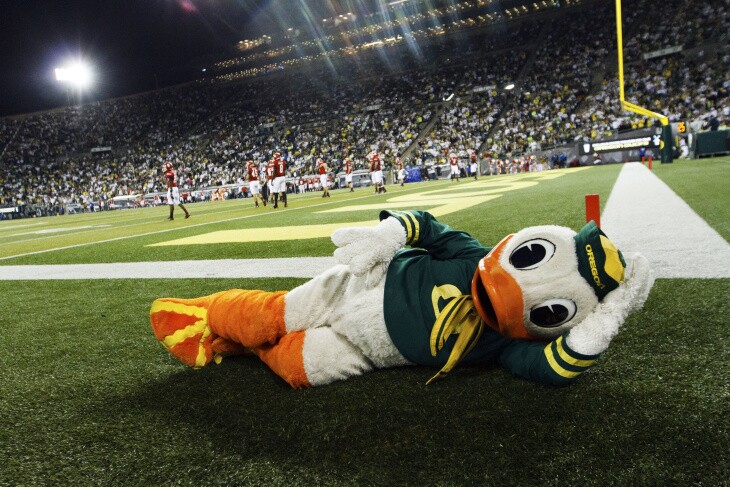Truth matters. Community matters. Your support makes both possible. LAist is one of the few places where news remains independent and free from political and corporate influence. Stand up for truth and for LAist. Make your year-end tax-deductible gift now.
Rose Bowl 2020: How Donald Duck Became A Mascot For The University Of Oregon

There are no local teams in this year's Rose Bowl matchup, which pits the University of Oregon Ducks against the University of Wisconsin Badgers. But if you feel like you've seen Oregon's mascot lurking around a certain Anaheim theme park, it's because you have.
Oregon has employed Donald Duck as a mascot at football games for decades.
So how did the famously restrictive entertainment giant come to allow a university from another state to use the famous duck's likeness?

It comes down to a handshake deal in 1947 between then-athletic director Leo Harris and Walt Disney himself, according to Zach Bigalke, a contributing writer at Saturday Blitz who has been covering sports since 2006.
Bigalke also happened to be a research assistant for the University of Oregon's "Documenting UO History Project," where he focused on the university's sports history, including the history of the Duck mascot.
Bigalke wrote a two-part series for the university documenting this history, which began long before the Ducks were even called the Ducks.
RISE OF THE WEBFOOT
The school started playing football in 1894, but they had no mascot at the time, Bigalke told KPCC's Take Two.
The informal nickname was the "lemon yellow" because of the piping on their uniforms, but they soon came to be called the Webfoot, "a pejorative that started in New England somewhere around Massachusetts in the 1700s for locals who would live in wet conditions."
WHY IT WAS CHANGED TO "DUCKS"
"Webfoot" stuck for a while, but it was sportswriters who likely introduced the nickname we now know. To save a couple of typeface lines in print, they would shorten "webfoot" to "ducks," Bigalke said.
The new name wasn't officially recognized by the university until the 1920s. That's when some people at the school really began to embrace it. A fraternity even started bringing a live duck to football and basketball games, giving rise to an early mascot, "Puddles the Duck." The Humane Society eventually put the kibosh on using live animals as a mascot.

ENTER DISNEY
In the '40s, then-athletic director Leo Harris decided the school needed a visual representation of this duck moniker.
"And he ends up making a handshake deal with Walt Disney in 1947, where the Disney company allows basically Oregon to use Donald Duck's likeness as long as it was used in what they said should be a 'reputable manner,'" Bigalke said.
Disney continued having a say in how Donald Duck's image was portrayed and where it could be used and where it was licensed, Bigalke said. That meant you might see the mascot at the stadium or in the campus bookstore, but not on any other merchandise. Disney even had a lot of influence over where the person in the physical duck costume could actually go, Bigalke said.
MAKING IT OFFICIAL, THEN UNOFFICIAL
Over the next two decades, the studio produced several versions of the duck mascot in collaboration with the university.
But when Disney died in 1966, they realized there had never been a formal contract. So for the next seven years, the school and Disney developed a contract around how Donald's image could be used.
In 2010, Disney began to dissociate itself from the physical Ducks mascot. The studio still maintains image rights over different representations of the Donald character and how it's used on merchandise and memorabilia, but they have loosened the reigns on the duck itself, Bigalke said.
Over the years, and as early as the 1970s, students and coaches have tried to change the mascot. The campus newspaper, the Emerald, even had a contest to create a new duck image. But by then the idea had pretty much stuck.
Which is why you still see this guy at the big games:

Brian Frank contributed to this story.







